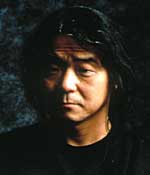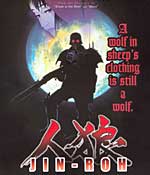
by Luis Reyes
On May 25, Production I.G's "Jin-Roh" premiered at California State University, Long Beach's Japanese Animation Festival. Slipping into the first interview slot of the day, Akadot spoke with the film's author. The legendary Mamoru Oshii steps into the interview room donning his characteristic black blazer, jeans and white tennis shoes. His mop of black hair and wide jovial face belie his age, and as he slides onto the interview couch he's seized with an air of indifference, as if speaking about his work only keeps him from making more. But he's courteous and personable, and after awhile absorbed in conversation about "Jin-Roh." He's extremely articulate about his work, driven as it is by an underlying, idiosyncratically Oshii philosophy that has developed in complexity from his early work on "Urusei Yatsura," through the transitional "Patlabor" franchise, until reaching maturation in the ground-breaking "Ghost in the Shell." Rooted in exploring mankind's relationship to its world, Oshii's questions have become those of personal identity, an issue with which "Ghost's" Major Kusanagi wrestles, and an issue for which "Jin-Roh's" Kazuki Fuse would sacrifice his humanity. Translated as "The Wolf Brigade," "Jin-Roh," authored by Oshii (who then chose novice director Hiroyuki Okiura to helm the project), marks the fourth time Oshii has visited the theme of the wolf spirit as a characteristic of identity. According to the official press packet released by Bandai Entertainment and Viz Communications, he "portrayed the world of 'Jin-Roh' both in earlier manga he wrote, and in live-action films he directed (1986's 'The Red Spectacles' and 1991's 'Kerberos Panzer Cops: Stray Dog)." But this is the first time that Oshii, renowned in the anime field, has addressed the theme in animation. Would you have wanted to direct "Jin-Roh?"
Oshii: Yes.
What prevented it? Oshii: Two reasons. One, I was already preparing for another movie project and, two, Bandai Visual told
me that they didn't want me to direct it. They said that if I had directed it, the film would have been a very
complicated movie to watch.
"Jin-Roh" as it turned out isn't a complicated movie? Oshii: Yeah, it still is, just not as complicated.
By setting "Jin-Roh" in a post-war alternate past, what kind of comments did you want to make about Japanese history? Oshii: That was a time when Japan was still deciding which way to re-build, so there were a lot of political
disputes going on. In reality, America was trying to occupy Japan, but in the story of "Jin Roh," it's Germany trying to
occupy Japan.
Is "Jin-Roh" trying to strike a similar chord to "Blood," sounding the Japanese resentment to an American presence in the post-war era? Oshii: It wasn't necessarily America that they didn't want to welcome, but just anything non-Japanese trying to
occupy. That's what they did not welcome.
The question of with which of the two main characters to sympathize is a troubling one in "Jin Roh" - Kei Amemiya, a revolutionary terrorist, or Kazuki Fuse, the soldier who has been trained not to respond to his emotions. As an audience, are we supposed to sympathize with either of them individually or both of them together or neither one of them? Oshii: It's all up to the audience to decide.
Would you say that you made a conscious attempt not to judge either one of them in the story? Is either one of them a hero? Oshii: You mean hero as in main character.
As in the person we are supposed to follow, with whom our hearts are supposed to be. Oshii: When I wrote the script I made the soldier, Kazuki Fuse, the main character. When Okiura directed
it, the focus shifted to the girl, Kei Amemiya.
|


